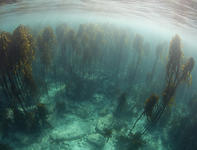
Name
Seaweeds (Chromalveolata)Alias
Sea PlantsSize
Seaweeds, such as kelp, can be up to 15 m long.Seaweeds Identification
Sea plants occur in different shapes and sizes, ranging from single cell to large multicellular organisms. They are predominantly green, red and brown in colour.Seaweeds General Info
Seaweeds are a part of the Chromalveolata kingdom which includes brown, green and red algae. Chlorophyta, or green algae, have three body forms: flat sheets, tubes and filaments located end to end.
Phaeophyta, or brown algae, occur in a wide variety of body forms, including fans, forking plants, cushions and tree-like kelps.
Rhodophyta, or red algae, is the largest group, all of which have chlorophyll for photosynthesis. These plants are tough and can withstand waves, and produce spores or gametes for reproduction.
Seaweeds Feeding
Seaweeds grow by means of photosynthesis.Distribution
They can be found in all temperate and tropical oceans across the world.Common Species
Bladder kelp (Macrocystis sp)Different leafed sargassum (Sargassum heterophyllum)
Upright codium (Codium extricatum)